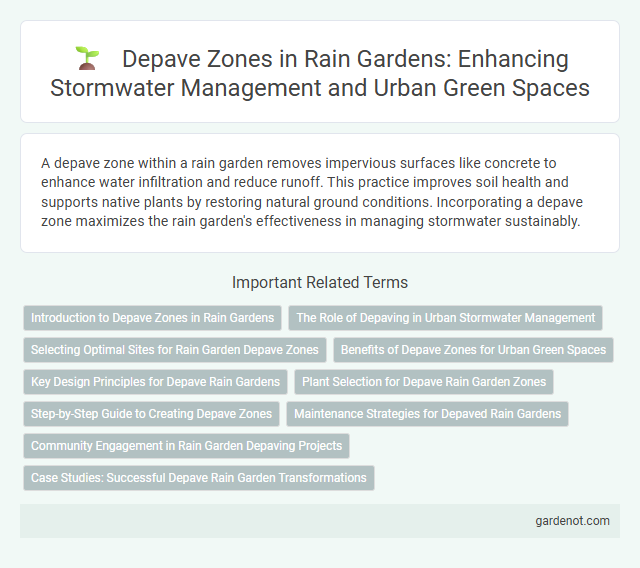A depave zone within a rain garden removes impervious surfaces like concrete to enhance water infiltration and reduce runoff. This practice improves soil health and supports native plants by restoring natural ground conditions. Incorporating a depave zone maximizes the rain garden's effectiveness in managing stormwater sustainably.
Introduction to Depave Zones in Rain Gardens
Depave zones in rain gardens are specifically designed areas where impervious surfaces such as concrete or asphalt are removed to increase soil permeability. These zones enhance stormwater infiltration, reduce runoff, and promote groundwater recharge by allowing rainwater to naturally filter through native soil and vegetation. Implementing depave zones supports urban green infrastructure, improves water quality, and mitigates flooding risks in densely paved environments.
The Role of Depaving in Urban Stormwater Management
Depave zones play a crucial role in urban stormwater management by replacing impervious surfaces with permeable landscapes that enhance water infiltration. These areas reduce runoff volume and pollutant loads by capturing rainwater, thereby mitigating flooding and improving groundwater recharge. Implementing depaving strategies supports sustainable urban drainage systems and contributes to healthier, more resilient urban ecosystems.
Selecting Optimal Sites for Rain Garden Depave Zones
Selecting optimal sites for rain garden depave zones involves identifying impervious surfaces such as parking lots, driveways, or underutilized pavement areas that contribute to stormwater runoff. Prioritize locations with direct runoff pathways to maximize water infiltration and reduce urban flooding. Soil permeability, sunlight exposure, and proximity to downspouts or drainage systems are critical factors for ensuring effective depave zone performance in rain gardens.
Benefits of Depave Zones for Urban Green Spaces
Depave zones transform impervious surfaces into permeable green spaces, significantly reducing urban runoff and mitigating flood risks. These zones enhance groundwater recharge, improve water quality by filtering pollutants, and create habitats for urban wildlife. Implementing depave zones contributes to cooler urban temperatures and promotes biodiversity within densely built environments.
Key Design Principles for Depave Rain Gardens
Depave zones in rain garden design prioritize permeable surfaces to enhance stormwater infiltration and reduce runoff. Incorporating native plants with deep root systems maximizes soil stabilization and nutrient filtering capabilities. Strategically grading the area ensures optimal water capture and minimizes erosion, creating an efficient and sustainable rain garden ecosystem.
Plant Selection for Depave Rain Garden Zones
Selecting native, drought-tolerant plants is essential for depave rain garden zones to enhance infiltration and reduce runoff. Species like sedges, rushes, and wildflowers with deep root systems improve soil structure and support microbial activity, increasing water retention and filtration. Incorporating a diverse mix of perennials ensures year-round ecological benefits and resilience against urban stressors.
Step-by-Step Guide to Creating Depave Zones
Creating a depave zone begins with selecting an area of impervious surface such as asphalt or concrete for removal to reduce runoff and increase groundwater infiltration. The process involves carefully breaking up and removing the pavement, then loosening compacted soil beneath to restore permeability. Finally, native plants and permeable materials are installed to maximize absorption and enhance local biodiversity in the rain garden system.
Maintenance Strategies for Depaved Rain Gardens
Effective maintenance strategies for depaved rain gardens include regular inspection and removal of sediment, debris, and invasive species to ensure optimal water infiltration and plant health. Periodic mulching with organic material supports soil moisture retention and nutrient cycling, enhancing the garden's ecological function. Establishing a seasonal schedule for pruning and replanting native species promotes long-term resilience and biodiversity in the depave zone.
Community Engagement in Rain Garden Depaving Projects
Depave zones transform impervious surfaces into rain gardens, enhancing stormwater management and urban biodiversity. Community engagement in rain garden depaving projects fosters local stewardship, increases environmental awareness, and encourages collective action towards sustainable water practices. Collaborative efforts often include workshops, volunteer planting days, and educational outreach to maximize participation and long-term maintenance.
Case Studies: Successful Depave Rain Garden Transformations
Depave zones have demonstrated significant success in transforming impervious surfaces into thriving rain gardens, effectively reducing stormwater runoff and improving urban water quality. Case studies from cities like Portland, Oregon, and Vancouver, British Columbia, highlight measurable benefits such as a 30-50% decrease in surface water runoff and increased biodiversity through native plant restoration. These projects showcase practical examples of community engagement and sustainable urban design enhancing local ecosystems while mitigating flood risks.
Depave zone Infographic

 gardenot.com
gardenot.com